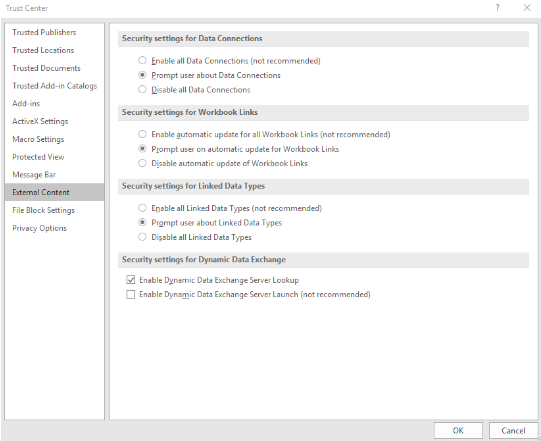6 Simple Techniques For Excel Links Not Working
Wiki Article
The Ultimate Guide To Excel Links Not Working
Table of ContentsExcel Links Not Working Things To Know Before You BuySome Known Details About Excel Links Not Working The 10-Second Trick For Excel Links Not WorkingSome Known Questions About Excel Links Not Working.Our Excel Links Not Working Statements

Nevertheless, range computation features like either can not handle whole column recommendations or calculate all the cells in the column. User-defined features don't instantly identify the last-used row in the column and, for that reason, regularly compute whole column referrals inefficiently. It is simple to program user-defined features so that they identify the last-used row.

Excel Links Not Working - Truths
Utilizing the formula for a dynamic variety is generally preferable to the formula due to the fact that has the drawback of being a volatile feature that will be calculated at every recalculation. Performance lowers because the feature inside the vibrant range formula have to analyze numerous rows.$A$ 1) - 1,1) You can also use features such as to construct vibrant arrays, however is unstable as well as constantly determines single-threaded.
Making use of multiple vibrant varieties within a single column requires special-purpose checking features. Making use of many vibrant varieties can decrease performance. In Workplace 365 variation 1809 and later on, Excel's VLOOKUP, HLOOKUP, and also suit for exact suit on unsorted information is much faster than ever before when searching for numerous columns (or rows with HLOOKUP) from the same table range.
If you use the exact match choice, the computation time for the feature is proportional to the number of cells checked prior to a suit is found. Lookup time making use of the approximate match alternatives of,, and on arranged information is rapid and also is not considerably increased by the length of the range you are looking up.
Things about Excel Links Not Working
Make sure that you comprehend the match-type and range-lookup alternatives in,, and. The complying with code example reveals the phrase structure for the feature. SUIT(lookup value, lookup variety, matchtype) returns the largest suit much less than or equivalent to the lookup worth when the lookup array is arranged ascending (approximate suit).The default choice is approximate match sorted ascending. requests an exact suit and presumes that the data is not arranged. returns the tiniest suit higher than or equivalent to the lookup value if the lookup range is arranged descending (approximate suit). The complying with code example shows the syntax for the and functions.
VLOOKUP(lookup worth, table selection, col index num, range-lookup) HLOOKUP(lookup worth, table range, row index num, range-lookup) returns the biggest suit much less than or equivalent to the lookup value (approximate match). Table selection have to be sorted rising.
See This Report about Excel Links Not Working
If your data is arranged, yet you desire This Site a precise match, see Usage 2 lookups for sorted information with missing worths. Attempt making use of the and functions as opposed to. Although is slightly quicker (around 5 percent quicker), easier, and makes use of less memory than a combination of and, or, the additional versatility that navigate to these guys and offer usually allows you to significantly conserve time.
The function is quick and is a non-volatile function, which speeds up recalculation. The feature is also fast; however, it is an unpredictable function, and also it sometimes considerably enhances the time taken to process the computation chain.$A$ 2:$F$ 1000, MATCH(A1,$A$ 1:$A$ 1000,0),3) Since precise suit lookups can be slow-moving, think about the adhering to options for enhancing efficiency: Use one worksheet.
When you can, the data initially (is quick), as well as utilize approximate match. When you must utilize a precise suit lookup, restrict the array of cells to be scanned to a minimum. Usage tables and organized references or vibrant array names as opposed to referring to a large number of rows or columns.
The Best Guide To Excel Links Not Working
Two approximate matches are dramatically faster than one specific match for a lookup over greater than a few rows. (The breakeven factor has to do with 10-20 rows.) If you can sort your data however still can not utilize approximate match because you can not make certain that the value you are searching for exists in the lookup variety, you can utilize this formula: IF(VLOOKUP(lookup_val, lookup_array,1, Real)=lookup_val, _ VLOOKUP(lookup_val, lookup_array, column, True), "notexist") The initial component of the formula works by doing click to investigate an approximate lookup on the lookup column itself.VLOOKUP(lookup_val, lookup_array, column, Real) If the answer from the lookup column did not match the lookup value, you have a missing value, and the formula returns "notexist". Know that if you seek out a value smaller sized than the tiniest worth in the listing, you get an error. You can handle this error by utilizing, or by adding a small test worth to the listing.
Starting with Excel 2007, you can utilize the feature, which is both simple and rapid. IF IFERROR(VLOOKUP(lookupval, table, 2 FALSE),0) In earlier versions, an easy yet slow-moving means is to utilize a feature that has 2 lookups. IF(ISNA(VLOOKUP(lookupval, table,2, FALSE)),0, _ VLOOKUP(lookupval, table,2, FALSE)) You can stay clear of the dual precise lookup if you utilize precise once, save the lead to a cell, as well as after that evaluate the result prior to doing an.
Report this wiki page